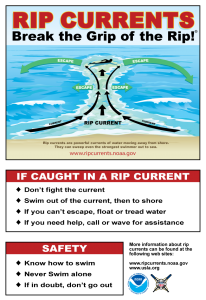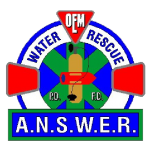Rip Current Safety Information provided by Neptune Township Office of Emergency Management (OEM) and the Area Network of Shore Water Emergency Responders (A.N.S.W.E.R.).
 About Rip Currents
About Rip Currents
Rip currents are powerful, channeled currents of water flowing away from shore. They typically extend from the shoreline, through the surf zone, and past the line of breaking waves. Rip currents can occur at any beach with breaking waves, including the Great Lakes.
Rip currents can be killers. The United States Lifesaving Association estimates that the annual number of deaths due to rip currents on our nation’s beaches exceeds 100. Rip currents account for over 80% of rescues performed by surf beach lifeguards.
The greatest safety precaution that can be taken is to recognize the danger of rip currents and always remember to swim at beaches with lifeguards. The United States Lifesaving Association has calculated the chance that a person will drown while attending a beach protected by USLA affiliated lifeguards at 1 in 18 million. If caught in a rip current at an unguarded beach, how you respond could make the difference between life and death.
The United States Lifesaving Association, in partnership with NOAA’s National Weather Service and National Sea Grant Program, is working together to raise awareness about the dangers of rip currents. Research is also being conducted inorder to develop and improve the ability to predict the occurrence and strength of rip currents. The goal of the awareness campaign and research is to reduce the number of rip current related fatalities.
With increasing coastal populations, rip currents will continue to be a serious hazard at surf beaches. This web site is designed to provide educational material as well as real time information about the rip current risk. The time you take to understand rip currents can help you protect yourself and your loved ones when visiting the beaches.
Why Rip Currents Form
As waves travel from deep to shallow water, they will break near the shoreline. When waves break strongly in some locations and weakly in others, this can cause circulation cells which are seen as rip currents: narrow, fast-moving belts of water traveling offshore.
Why Rip Currents are Dangerous
Rip currents are the leading surf hazard for all beachgoers. They are particularly dangerous for weak or non-swimmers. Rip current speeds are typically 1-2 feet per second. However, speeds as high as 8 feet per second have been measured–this is faster than an Olympic swimmer can sprint! Thus, rip currents can sweep even the strongest swimmer out to sea.
Over 100 drownings due to rip currents occur every year in the United States.More than 80% of water rescues on surf beaches are due to rip currents.
Rip currents can occur at any surf beach with breaking waves, including the Great Lakes.
https://www.youtube.com/watch?v=LX2o-QpXSso
When Rip Currents Form
Rip currents can be found on many surf beaches every day. Under most tide and sea conditions the speeds are relatively slow. However, under certain wave, tide, and beach profile conditions the speeds can quickly increase to become dangerous to anyone entering the surf. The strength and speed of a rip current will likely increase as wave height and wave period increase. They are most likely to be dangerous during high surf conditions as the wave height and wave period increase.
Where Rip Currents Form
Rip currents most typically form at low spots or breaks in sandbars, and also near structures such as groins, jetties and piers. Rip currents can be very narrow or extend in widths to hundreds of yards. The seaward pull of rip currents varies: sometimes the rip current ends just beyond the line of breaking waves, but sometimes rip currents continue to push hundreds of yards offshore.
How to Identify Rip Currents
Look for any of these clues:
- a channel of churning, choppy water
- an area having a notable difference in water color
- a line of foam, seaweed, or debris moving steadily seaward
- a break in the incoming wave pattern
None, one, or more of the above clues may indicate the presence of rip currents. Rip currents are often not readily or easily identifiable to the average beachgoer. For your safety, be aware of this major surf zone hazard. Polarized sunglasses make it easier to see the rip current clues provided above.
How to Avoid and Survive Rip Currents
- Learn how to swim!
- Never swim alone.
- Be cautious at all times, especially when swimming at unguarded beaches. If in doubt, don’t go out!
- Whenever possible, swim at a lifeguard protected beach.
- Obey all instructions and orders from lifeguards.
- If caught in a rip current, remain calm to conserve energy and think clearly.
- Don’t fight the current. Swim out of the current in a direction following the shoreline. When out of the current, swim towards shore.
- If you are unable to swim out of the rip current, float or calmly tread water. When out of the current, swim towards shore.
- If you are still unable to reach shore, draw attention to yourself: face the shore, wave your arms, and yell for help.
- If you see someone in trouble, get help from a lifeguard. If a lifeguard is not available, have someone call 9-1-1 . Throw the rip current victim something that floats and yell instructions on how to escape. Remember, many people drown while trying to save someone else from a rip current.
Rip Current Myth
A rip current is a horizontal current. Rip currents do not pull people under the water–-they pull people away from shore. Drowning deaths occur when people pulled offshore are unable to keep themselves afloat and swim to shore. This may be due to any combination of fear, panic, exhaustion, or lack of swimming skills.
In some regions rip currents are referred to by other, incorrect terms such as rip tides and undertow. We encourage exclusive use of the correct term – rip currents. Use of other terms may confuse people and negatively impact public education efforts.
Source: NOAA and USLA
##


